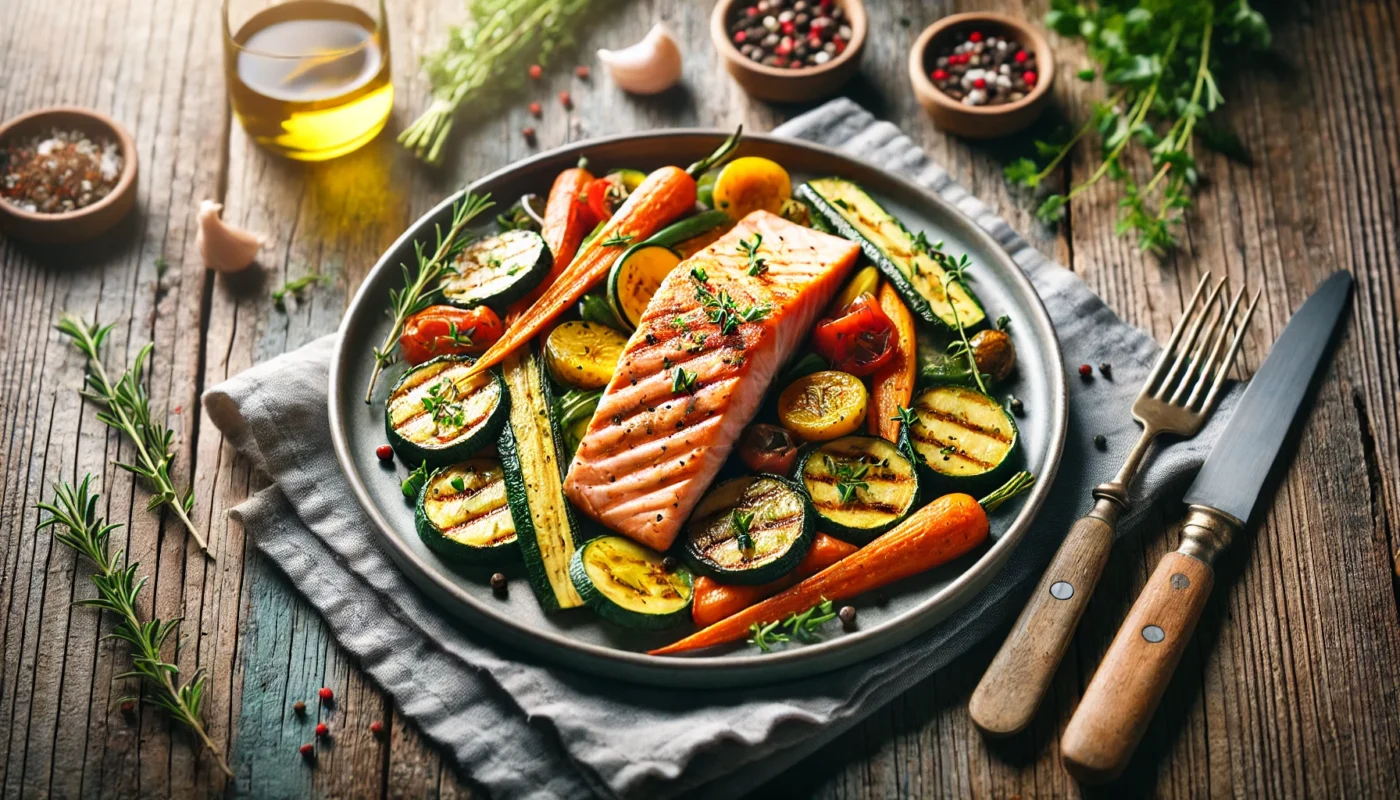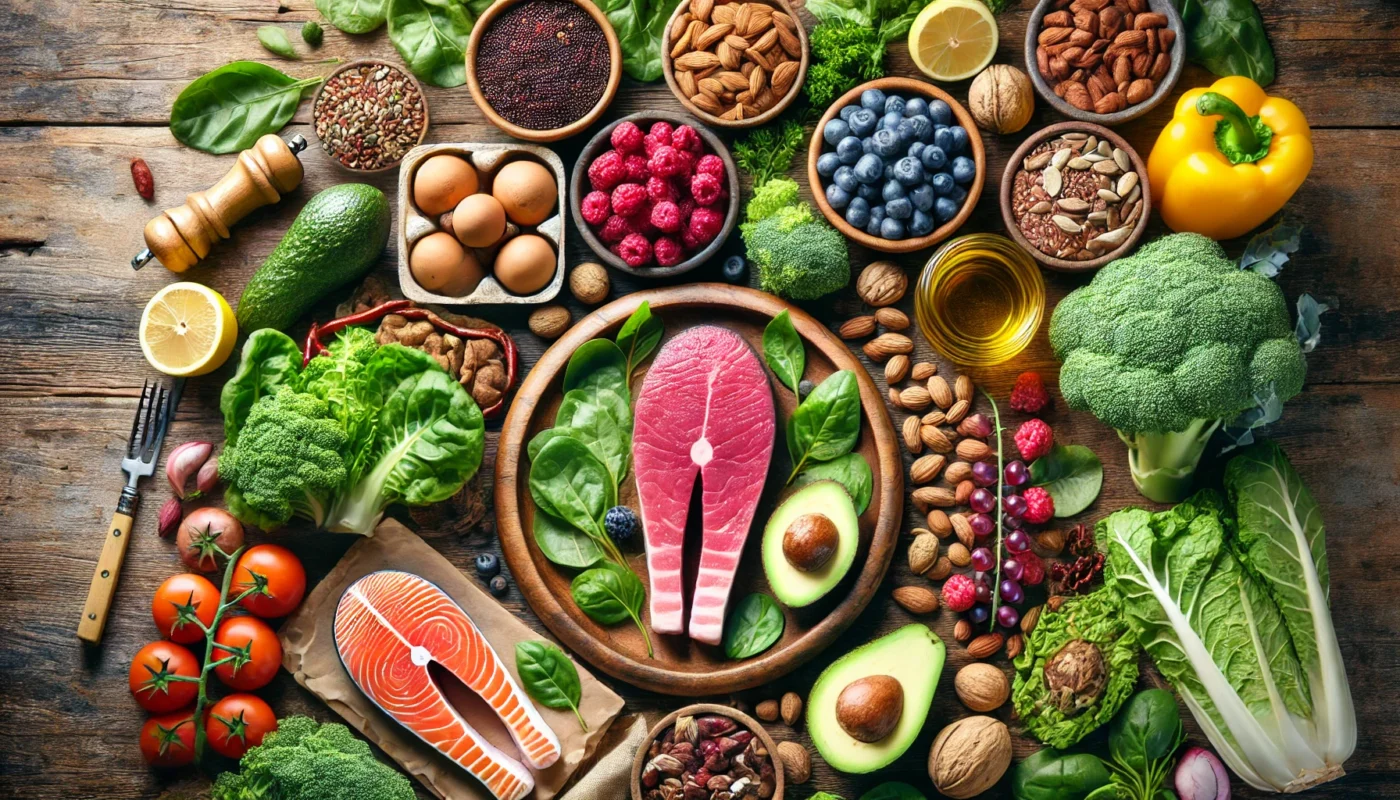The Paleo Diet, also known as the Paleolithic or “caveman” diet, is based on the notion of eating as our ancestors did during the Paleolithic era. The diet primarily includes lean meats, fish, fruits, vegetables, nuts, and seeds, while excluding processed foods, grains, legumes, and dairy. The emphasis is on consuming foods that are as close to their natural state as possible.
Origins and Evolution
The concept of the Paleo Diet originated in the 1970s, evolving from the idea that our genetic makeup is adapted to the diet of our prehistoric ancestors. The diet gained popularity as more people became interested in ancestral health and evolutionary biology. Over the years, researchers and enthusiasts have refined the diet to better suit modern nutritional needs while staying true to its fundamental principles.
Key Components and Restrictions
The Paleo Diet’s focus on whole foods includes a diverse range of nutrient-dense options. Lean meats such as grass-fed beef, free-range poultry, and wild-caught fish are staples. Fresh fruits and vegetables provide essential vitamins and minerals, while nuts and seeds offer healthy fats. The exclusion of grains, legumes, and dairy is based on the premise that these foods were not part of early human diets and may contribute to inflammation and digestive issues.
Nutritional Benefits
Adherents of the Paleo Diet often report increased energy levels, better digestion, and weight loss. The diet’s emphasis on whole foods naturally reduces the intake of refined sugars and unhealthy fats, promoting overall health. Additionally, the high intake of fiber from fruits and vegetables supports gut health, which is crucial for maintaining a balanced immune response.
You May Also Like: Exploring the Irish Autoimmune Diet Benefits
The Rationale Behind the Paleo Diet
The core idea of the Paleo Diet is that modern diets are misaligned with our evolutionary biology, which leads to various health problems, including inflammation and autoimmune diseases. The diet aims to eliminate foods that are thought to contribute to inflammation and, by extension, autoimmune symptoms.
Evolutionary Misalignment
Proponents of the Paleo Diet argue that the rapid shift from hunter-gatherer diets to agriculture-based diets has not allowed human genetics to adapt, resulting in a mismatch that may contribute to chronic diseases. The diet seeks to correct this misalignment by returning to a way of eating that is more in harmony with our genetic blueprint.
Inflammation and Modern Diets
Modern diets are often high in processed foods, refined sugars, and unhealthy fats, all of which can contribute to inflammation. Chronic inflammation is a known risk factor for various diseases, including autoimmune conditions. By eliminating these inflammatory foods, the Paleo Diet aims to reduce the body’s inflammatory response, potentially alleviating symptoms associated with autoimmune disorders.
Autoimmune Symptom Management
Autoimmune diseases are characterized by the immune system attacking healthy tissues, often leading to inflammation and pain. The Paleo Diet’s emphasis on anti-inflammatory foods, combined with the exclusion of potential irritants, may help reduce the frequency and severity of autoimmune flare-ups. Many individuals with autoimmune conditions report symptom relief when following a Paleo-style diet.

The Link Between Paleo and Autoimmune Relief
Autoimmune diseases occur when the immune system mistakenly attacks healthy cells, leading to inflammation and tissue damage. The Paleo Diet’s focus on anti-inflammatory foods may help mitigate these symptoms.
Anti-inflammatory Foods and Their Role
Anti-inflammatory foods, such as omega-3-rich fish, leafy greens, and nuts, are staples of the Paleo Diet. These foods are believed to help reduce inflammation, which is a key factor in managing autoimmune conditions. By minimizing processed foods and refined sugars, which can exacerbate inflammation, the Paleo Diet may offer a natural approach to managing autoimmune symptoms.
Gut Health and Autoimmunity
The health of the gut is closely linked to immune function. A compromised gut lining can lead to increased permeability, known as “leaky gut,” which may trigger or exacerbate autoimmune responses. The Paleo Diet promotes gut health by eliminating foods that irritate the digestive tract and incorporating foods that support gut healing, such as bone broth and fermented vegetables.
Scientific Evidence Supporting Paleo for Autoimmune Disease
While research on the Paleo Diet and autoimmune disease is still emerging, some studies suggest potential benefits. A 2014 study published in the Journal of Internal Medicine found that a Paleo-like diet improved glucose control and lipid profiles in individuals with type 2 diabetes, a condition often associated with inflammation. Another study in the European Journal of Clinical Nutrition reported that the Paleo Diet improved blood pressure and lipid profiles, both of which are markers of inflammation.
Comparative Studies
Comparative studies have also examined the effects of the Paleo Diet versus other dietary approaches on inflammation and autoimmune symptoms. Some research indicates that the Paleo Diet may be more effective in reducing markers of inflammation compared to standard Western diets. However, more large-scale, randomized controlled trials are needed to establish definitive conclusions.
Patient Testimonials and Anecdotal Evidence
While scientific studies provide valuable insights, anecdotal evidence from individuals following the Paleo Diet cannot be overlooked. Many people with autoimmune conditions have shared personal stories of symptom improvement and increased quality of life after adopting the diet. These testimonials, while subjective, underscore the potential of the Paleo Diet as a complementary approach to traditional medical treatments.
Implementing the Paleo Diet for Autoimmune Relief
Transitioning to a Paleo Diet requires careful planning and consideration. Here are some steps to help you get started:
Step 1: Educate Yourself
Before making dietary changes, it’s essential to understand the principles of the Paleo Diet and how they align with your health goals. Familiarize yourself with the types of foods you can eat and those to avoid.
Resources and Research
Begin by exploring books, documentaries, and online resources dedicated to the Paleo Diet. Understanding the scientific rationale and historical context can provide a deeper appreciation for the diet. Consider joining online forums or local support groups where you can share experiences and learn from others on the same journey.
Consulting Experts
Consider consulting a nutritionist or dietitian experienced in the Paleo Diet to tailor the approach to your individual needs. A professional can provide personalized guidance, help identify potential food sensitivities, and ensure you’re meeting your nutritional requirements.
Step 2: Plan Your Meals
Create a meal plan that incorporates a variety of foods to ensure you’re getting all the necessary nutrients. Focus on lean proteins, plenty of vegetables, and healthy fats. Consider batch cooking or meal prepping to make the transition easier.
Building a Balanced Plate
A well-balanced Paleo meal typically includes a portion of protein, a generous serving of vegetables, and healthy fats. Experiment with different recipes to keep your meals exciting and varied. Incorporate herbs and spices for flavor, which can also offer additional health benefits.
Shopping and Preparation
Plan your grocery trips with a list of Paleo-friendly foods to avoid impulse purchases of non-compliant items. Prepping meals in advance can save time and reduce stress during the week. Consider investing in airtight containers to store pre-prepared meals and snacks.
Step 3: Gradual Transition
Making drastic changes overnight can be overwhelming. Start by gradually eliminating processed foods and incorporating more whole foods into your diet. This approach allows your body to adjust and makes the transition more sustainable.
Incremental Changes
Begin by replacing one meal or snack per day with a Paleo-friendly option. Gradually increase this number until your entire diet aligns with Paleo principles. This method allows your palate to adjust while minimizing feelings of deprivation.
Mindful Eating
Practice mindful eating by paying attention to how your body responds to different foods. Notice any changes in energy levels, digestion, or mood. This awareness can help reinforce positive dietary habits and identify foods that may not agree with you.
Step 4: Monitor Your Symptoms
Keep a journal to track your symptoms and any changes you notice after adopting the Paleo Diet. This can help you identify which foods trigger symptoms and adjust your diet accordingly.
Tracking Progress
Document your meals, symptoms, and any notable changes in a daily journal. Over time, patterns may emerge that help you pinpoint foods or behaviors that influence your health. This information can be invaluable when adjusting your diet or consulting with healthcare professionals.
Adjustments and Flexibility
Be open to adjusting your diet based on your observations. If certain foods seem to trigger symptoms, consider eliminating them for a period and reintroducing them later to confirm their effects. Flexibility and responsiveness to your body’s signals are key to long-term success.

The AIP: A Specialized Version of the Paleo Diet
The Autoimmune Protocol (AIP) is a more restrictive version of the Paleo Diet, specifically designed for individuals with autoimmune diseases. It eliminates additional foods that may trigger inflammation, such as nightshades, nuts, seeds, and eggs, and focuses on nutrient-dense, anti-inflammatory foods.
Benefits of the AIP
The AIP aims to reduce inflammation, promote gut health, and support the immune system. By eliminating potential triggers and focusing on healing foods, many people with autoimmune conditions report a reduction in symptoms and improved quality of life.
Enhanced Gut Healing
The AIP places a strong emphasis on gut health, removing foods that can irritate the digestive tract and incorporating elements known to support gut lining repair. This focus can be particularly beneficial for those with autoimmune conditions linked to gut permeability.
Immune System Support
AIP encourages the consumption of nutrient-dense foods rich in vitamins and minerals that support immune function. This includes foods high in antioxidants, which help protect cells from damage and reduce overall inflammation.
Challenges of the AIP
The AIP can be challenging to follow due to its restrictive nature. Social events, dining out, and meal variety may require additional planning. However, many find the benefits outweigh the challenges and report significant improvements in their health.
Social and Practical Considerations
Navigating social situations and eating out can be difficult on the AIP. It often requires explaining dietary restrictions to friends and family or calling ahead to restaurants to ensure compliant options are available. Meal prepping and carrying snacks can help mitigate these challenges.
Psychological and Emotional Impact
The restrictive nature of the AIP can also have psychological impacts, such as feelings of isolation or frustration. Engaging with supportive communities, both online and offline, can provide encouragement and share strategies for overcoming these hurdles.
Is Paleo Anti-inflammatory?
The anti-inflammatory potential of the Paleo Diet is a key reason it is considered for autoimmune relief. By focusing on whole, nutrient-dense foods and eliminating potential irritants, the Paleo Diet may help reduce inflammation and support overall health.
Mechanisms of Inflammation Reduction
The elimination of processed foods, sugars, and grains in the Paleo Diet is believed to decrease systemic inflammation. Foods rich in omega-3 fatty acids, such as fish, further contribute to this anti-inflammatory effect by balancing the omega-6 fatty acids prevalent in modern diets.
Long-term Health Implications
Although the Paleo Diet is often associated with short-term symptom relief, many followers report sustained health improvements over time. This may include reduced incidence of chronic disease, better weight management, and improved metabolic health. However, ongoing research is required to fully understand these long-term impacts.
Potential Drawbacks
While the Paleo Diet has many proponents, it’s not without its critics. Some argue that the diet is too restrictive and may lead to nutrient deficiencies if not carefully planned. Additionally, more research is needed to fully understand its long-term effects on autoimmune conditions.
Nutritional Considerations
Critics of the Paleo Diet often point out potential deficiencies in calcium and vitamin D due to the exclusion of dairy. Those following the diet should ensure they consume adequate amounts of these nutrients through alternative sources or supplements.
Scientific Skepticism
While anecdotal evidence supports the benefits of the Paleo Diet, the scientific community calls for more rigorous studies to validate these claims. Until more comprehensive research is conducted, the diet should be considered as part of a broader lifestyle approach to health management.

Practical Tips for Success
To maximize the benefits of the Paleo Diet for autoimmune relief, consider these practical tips:
- Stay Hydrated: Drink plenty of water to support digestion and overall health.
- Listen to Your Body: Pay attention to how your body responds to different foods and adjust your diet accordingly.
- Consult a Professional: Consider working with a healthcare professional or nutritionist familiar with the Paleo Diet to ensure you’re meeting your nutritional needs.
Staying Motivated
Maintaining motivation can be challenging, especially when first transitioning to a new diet. Set realistic goals and celebrate small victories along the way. Keeping a progress journal or sharing your journey with a supportive community can help sustain your commitment.
Adapting for Lifestyle
Adapt the Paleo Diet to fit your lifestyle rather than trying to fit your life around the diet. This may include modifying meal times, experimenting with new recipes, or incorporating fitness and relaxation practices that complement your dietary changes.
Community and Support
Engaging with a community of like-minded individuals can provide valuable support and encouragement. Online forums, social media groups, and local meetups can offer a wealth of information, recipe ideas, and shared experiences that make the transition smoother and more enjoyable.
Conclusion
The Paleo Diet offers a promising approach for those seeking relief from autoimmune symptoms. By focusing on anti-inflammatory foods and eliminating potential triggers, many individuals report significant improvements in their health. However, it’s important to approach the diet thoughtfully and consider consulting a healthcare professional to ensure it aligns with your unique health needs. Whether you choose the traditional Paleo Diet or the more specialized AIP, the potential for improved wellbeing is a compelling reason to explore this dietary approach.
By understanding the principles and benefits of the Paleo Diet, you can make informed decisions about your health and embark on a journey towards improved autoimmune relief and overall wellness. The path to health is personal and unique, and the Paleo Diet may be one valuable tool in your quest for optimal wellbeing.
Further Reading:
All you need to know about the AIP diet
A Little of This and That: Your Guide to the AIP Diet
Efficacy of the Autoimmune Protocol Diet for Inflammatory Bowel Disease
AIP, Paleo Diet, autoimmune conditions, gut health, inflammation, immune support, nutrition, dietary restrictions, health management, wellness, anti-inflammatory foods, nutrient-dense foods, meal prepping, psychological impact, community support
Important Note: The information contained in this article is for general informational purposes only, and should not be construed as health or medical advice, nor is it intended to diagnose, prevent, treat, or cure any disease or health condition. Before embarking on any diet, fitness regimen, or program of nutritional supplementation, it is advisable to consult your healthcare professional in order to determine its safety and probable efficacy in terms of your individual state of health.
Regarding Nutritional Supplements Or Other Non-Prescription Health Products: If any nutritional supplements or other non-prescription health products are mentioned in the foregoing article, any claims or statements made about them have not been evaluated by the U.S. Food and Drug Administration, and such nutritional supplements or other health products are not intended to diagnose, treat, cure, or prevent any disease.

